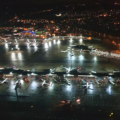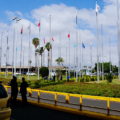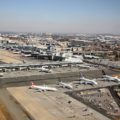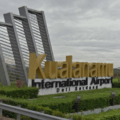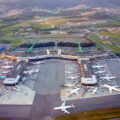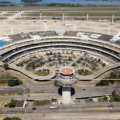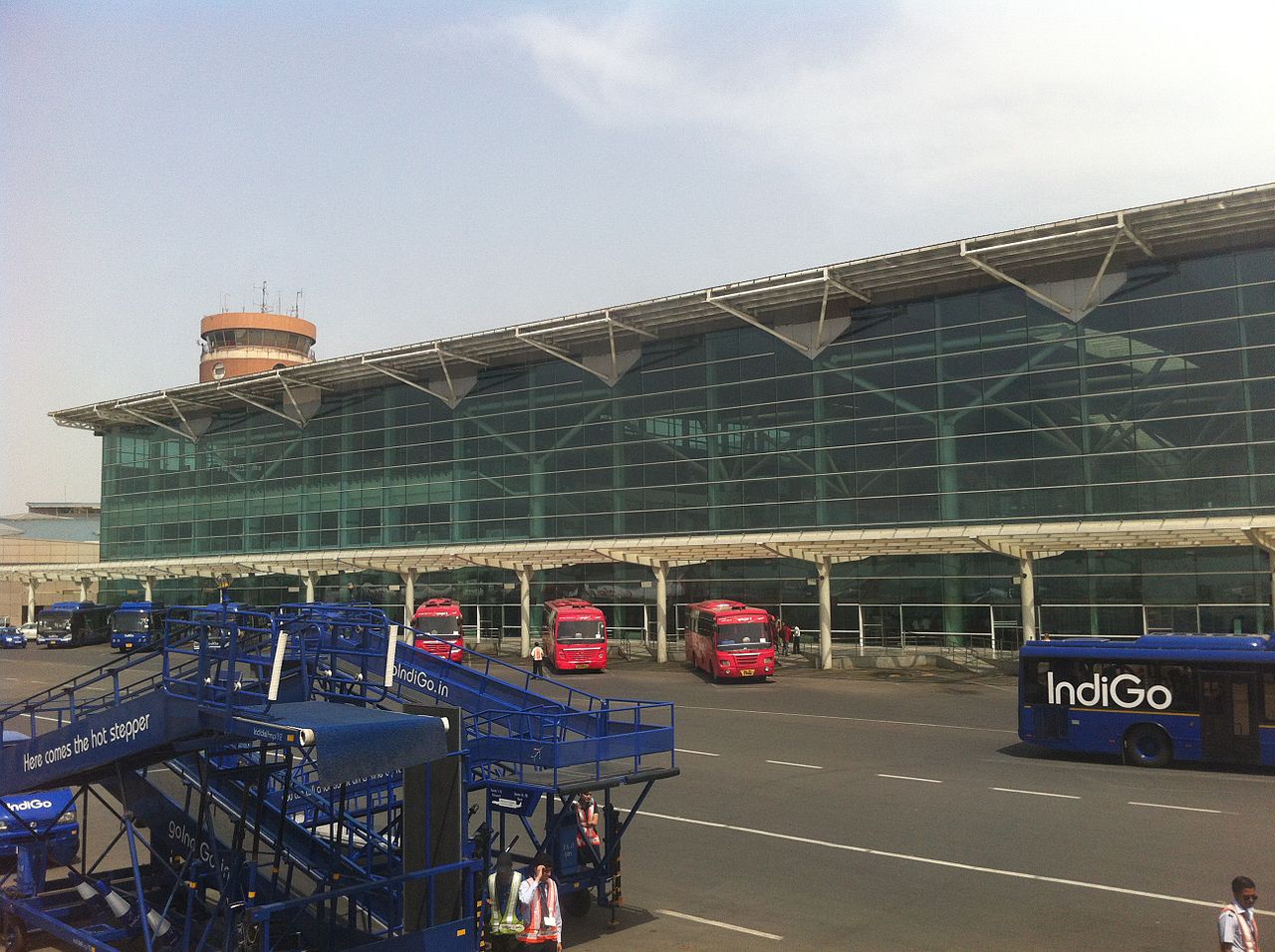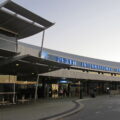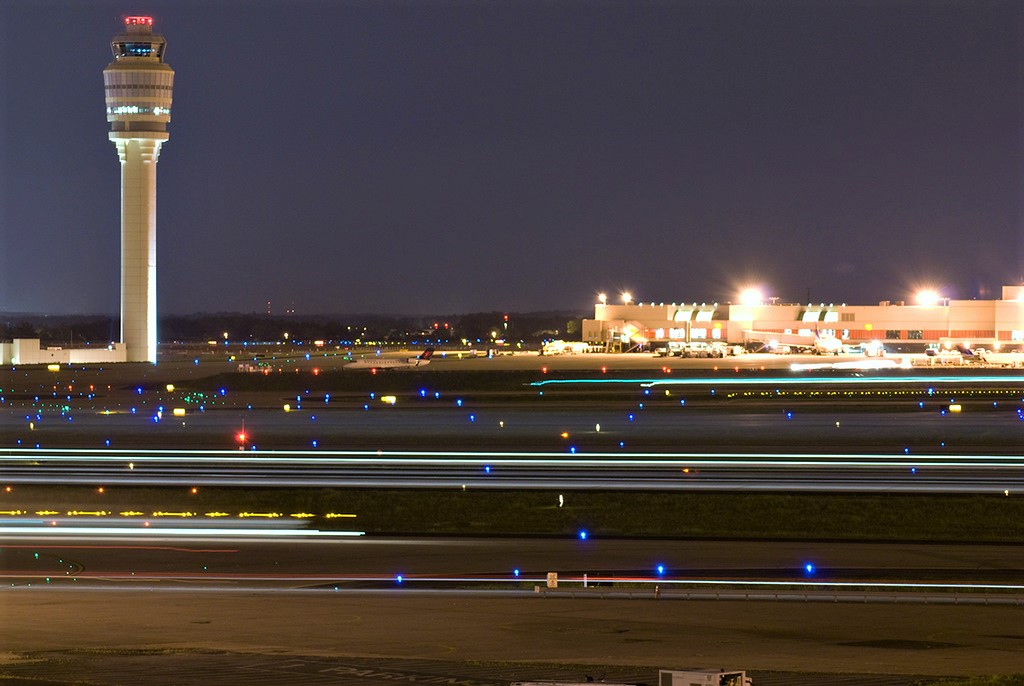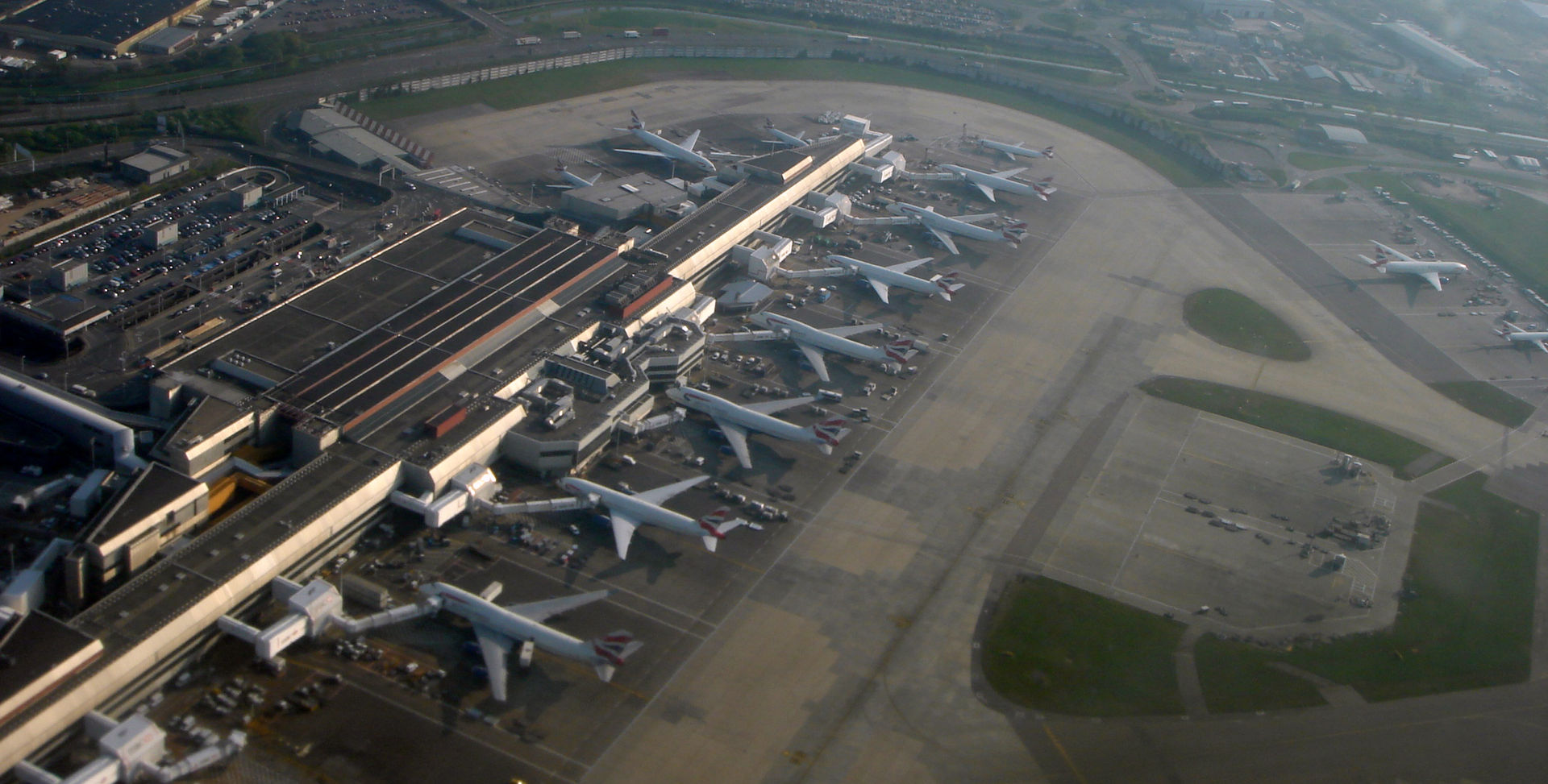Aviation
London Gatwick Airport
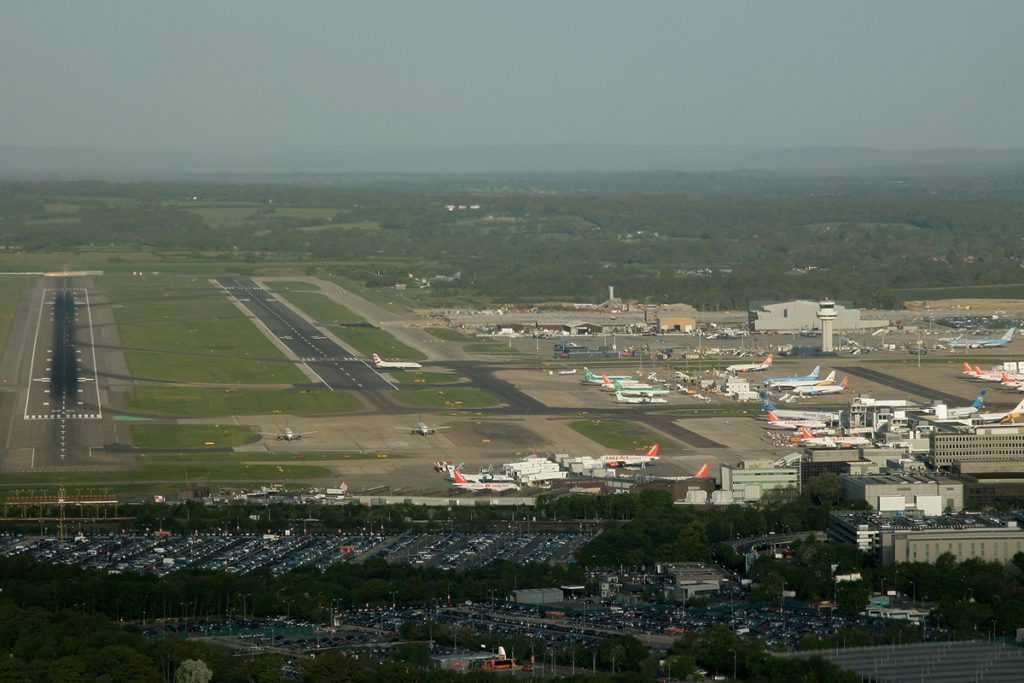
Source: Andre Wadman
| IATA: LGW ICAO: EGKK WMO: 03776 | |
| Airport type | Public |
| Operator | Gatwick Airport Limited |
| Serves | London, England |
| Location | Crawley, West Sussex |
| Hub for | British Airways Norwegian Air Shuttle |
| Focus city for | easyJet TUI Airways |
| Elevation AMSL | 203 ft / 62 m |
| Coordinates | |
| Website | www.gatwickairport.com |
Gatwick Airport (/ˈɡætwɪk/) also known as London Gatwick (IATA: LGW, ICAO: EGKK), is a major international airport near Crawley in West Sussex, southeast England, 29.5 miles (47.5 km) south of Central London. It is the second-busiest airport by total passenger traffic in the UK, after Heathrow Airport. Gatwick is the ninth-busiest airport in Europe. It covers a total area of 674 hectares (1,670 acres).
Gatwick opened as an aerodrome in the late 1920s; it has been in use for commercial flights since 1933. The airport has two terminals, the North Terminal and the South Terminal, which cover areas of 98,000 m2 (117,000 sq yd) and 160,000 m2 (190,000 sq yd) respectively. It operates as a single-runway airport, using a main runway with a length of 3,316 m (10,879 ft). A secondary runway is available but, due to its proximity to the main runway, can only be used if that is out of use. In 2018, 46.1 million passengers passed through the airport, a 1.1% increase compared with 2017. As of 2019, Gatwick is the second busiest airport in the world to operate only one runway (after Chhatrapati Shivaji Maharaj International Airport; until 2017, Gatwick was the busiest) with a passenger use of 46 million in 2018.


Ownership
The airport is owned and operated by Gatwick Airport Limited, a wholly owned subsidiary of Ivy Holdco Limited,[28] owned by Global Infrastructure Partners (GIP), among others. In December 2018, Vinci announced that it would acquire 50.01% majority stake for £2.9bn, with a GIP-managed consortium of investors (Abu Dhabi Investment Authority, Australia’s sovereign wealth fund and two public pension funds in California and South Korea) owning the remaining 49.9%. The sale was completed by the middle of 2019.
Operations
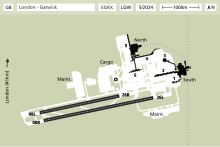

This file is licensed under the Creative Commons Attribution 4.0 International license.
Facilities
On 31 May 2008, Virgin Holidays opened the V Room, Gatwick’s first lounge dedicated to their long-haul leisure travellers. On 25 January 2017, the lounge moved to the North Terminal together with the Virgin Atlantic Clubhouse as part of the airline moves that saw British Airways and Virgin Atlantic exchange their previous terminal locations and EasyJet consolidated in the North Terminal. On 9 April 2009, an independent pay-for-access lounge opened in the South Terminal. Gatwick also has a conference and business centre, and several on- and off-site hotels ranging in class from executive to economy.
The airport has Anglican, Catholic and Free Church chaplains, and there are multi-faith prayer and counselling rooms in each terminal. A daily service is led by one of the chaplains.
The Civil Aviation Authority Safety Regulation Group is in Aviation House. WesternGeco, a geophysical services company, has its head office and Europe–Africa–Russia offices in Schlumberger House, a 124,000 sq ft (11,500 m2) building on the airport grounds near the South Terminal. The company had a 15-year lease on the building, scheduled to expire in June 2008. In 2007, WesternGeco reached an agreement with its landlord, BAA Lynton, extending its lease to 2016 at an initial rent of £2.1 million. Fastjet has its registered and head offices at Suite 2C in First Point at the airport.
Before the sale, BAA planned an £874 million investment at Gatwick over five years, including increased capacity for both terminals, improvements to transport interchange and a new baggage system for the South Terminal. Passengers passing through the airport are informed about the redevelopment programme with large mobile barcodes on top of construction hoardings. Scanning these transfers information on the construction to the user’s smartphone.
In summer 2013, Gatwick introduced Gatwick Connect, a free flight connection service to assist passengers changing flights at Gatwick whose airlines do not provide a full flight connection service. On 15 September 2015, the service was rebranded as “GatwickConnects”. It is available to passengers connecting on several major airlines.
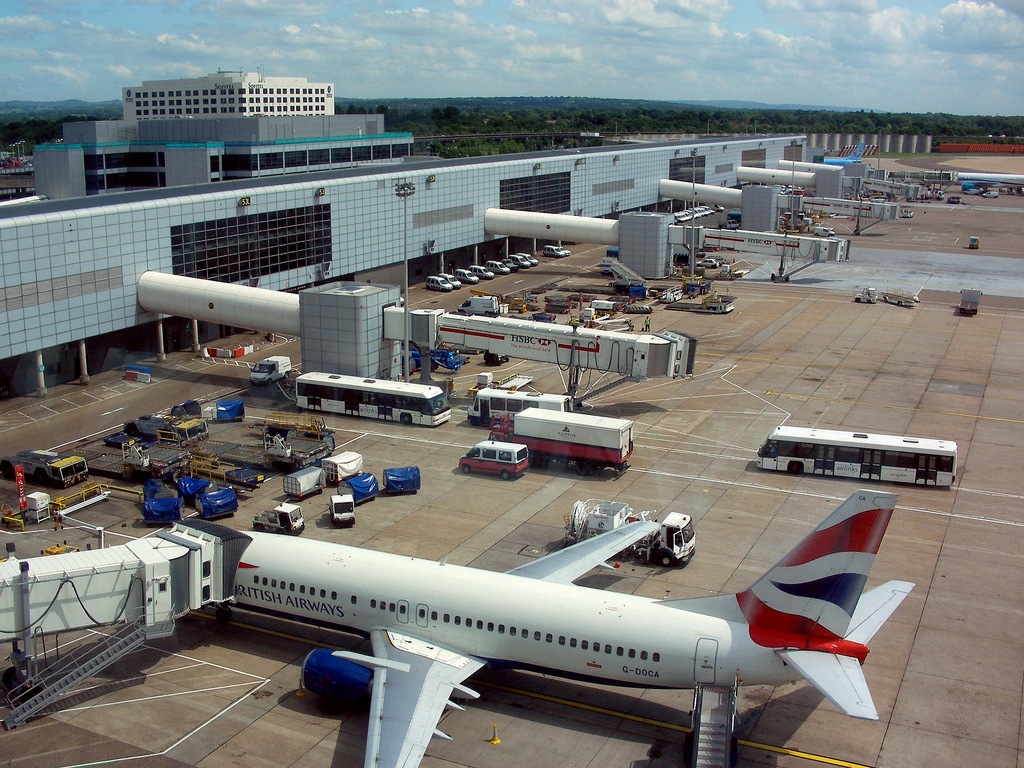

Source: Gatwick Airport, North Terminal
Flight movements


Source: From geograph.org.uk
Gatwick operates as a single-runway airport although it has two runways; the northern runway (08L/26R) can only be used when the main runway (08R/26L) is out of use for any reason. The UK Integrated Aeronautical Information Package gives the Takeoff Run Available (TORA) of its main runway (08R/26L) as 3,255 m when aircraft take off in a westerly direction (26) and 3,159 m when takeoffs occur in an easterly direction (08). The documentation lists the respective TORA for the northern runway (08L/26R) as 2,565 m in both directions. Nearly three-quarters of takeoffs are towards the west (74% over a 12-month period). Both runways are 148 ft (45 m) wide; they are 656 ft (200 m) apart, which is insufficient for the simultaneous use of both runways. During normal operations the northern runway is used as a taxiway, consistent with its original construction (although it was gradually widened).
In October 2018, the airport announced that it was “exploring how to make best use of its existing runways, including the possibility of bringing its existing standby runway into routine use”. One scenario would see 08L/26R used for departing narrow-body aircraft only, while the longer 08R/26L would be used for wide-body take-offs and all landings; widening 08L/26R would also increase the centreline separation slightly. New technology could also be used to increase capacity on the main runway, and in the longer term the airport remains interested in constructing a new runway to the south.
The main runway uses a Category III Instrument Landing System (ILS). The northern runway does not have an ILS; when it is in use, arriving aircraft use a combination of distance measuring equipment and assistance from the approach controller (using surveillance radar) or (where equipped, and subject to operator approval) an RNAV (GNSS) approach (also available for the main runway). On both runways, a continuous descent approach is used to minimise the environmental effects of incoming aircraft, particularly at night.
- Number of flights
- A Quota Count system, limiting total noise permitted
- No night QC/4 flights
Security
The airport is policed by the Gatwick District of Sussex Police. The district is responsible for the entire airport (including aircraft) and, in certain circumstances, aircraft in flight. The 150 officers attached to this district include armed and unarmed officers, and community support officers for minor offences. The airport district counters man-portable surface-to-air missiles (MANPADS) by patrolling in and around the airport, and a separate sub-unit has vehicle checks around the airport.
Access to airside portions of the airport is controlled and maintained by the airport’s team of security officers, regulated by the Department for Transport. Brook House, an immigration-removal centre of Immigration Enforcement, was opened near the airport on 18 March 2009 by the then Home Secretary Jacqui Smith.
Major airlines
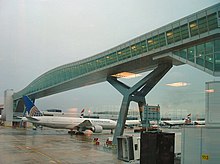

North Terminal to its apron pier
Source: From geograph.org.uk
The airport is a base for scheduled airlines British Airways (BA), EasyJet, Norwegian Air Shuttle and charter operators such as TUI Airways. Gatwick is unique amongst London’s airports in its representation of the three main airline business models: full service, low-cost and charter. As of October 2016, these respectively accounted for 26.6%,[nb 4] 61.3%[nb 4] and 13.1%[nb 5] of Gatwick’s seat capacity.
By late 2015, EasyJet flew over 100 routes from Gatwick with a fleet of more than 60 aircraft. The airport is the carrier’s largest base, and its 16 million passengers per year accounted for 45% of Gatwick’s 2013 total (ahead of Gatwick’s second-largest passenger airline: BA, whose 4.5 million passengers comprised 14% of total passenger traffic in 2011–12).[nb 6]
EasyJet, BA and Norwegian are Gatwick’s three biggest resident airlines. According to data from Airport Coordination Limited, these three airlines respectively accounted for 43.3%, 19% and 10.5% of airport slots in April 2018. According to this data, by April 2018 Norwegian had overtaken Virgin Atlantic as Gatwick’s number one transatlantic airline by seat capacity, and BA’s competitive response to Norwegian’s growing commercial threat to its transatlantic business would result in Virgin’s relegation to third position among the airport’s transatlantic airlines during the 2018 summer timetable period. EasyJet, BA and Norwegian collectively accounted for 65.43% of Gatwick’s total passengers in 2016 (EasyJet: 40.37% / 17.4 million; BA: 14.39% / 6.2 million; Norwegian: 10.67% / 4.6 million). As per Official Airline Guide (OAG) data for the week of 29 May 2017, their respective international departure seat capacity shares at the airport for summer 2017 are: 42.1%, 15.4% and 9.4%.
By 2008, Flybe was Gatwick’s third-largest airline (accounting for 9% of its slots) and its fastest-growing airline. It became the airport’s largest domestic operator, carrying 1.2 million passengers in its 2011–12 financial year on eight routes to destinations in the UK, the Channel Islands and the Isle of Man.[nb 6] In March 2013, the airline announced that it would end operations at Gatwick, citing unsustainably high airport charges and increases in UK Air Passenger Duty. Flybe sold its 25 pairs of daily slots[nb 8] at the airport to EasyJet for £20 million. The latter’s share of Gatwick slots increased to 44% in summer 2014; second-placed BA has held about 16% of the airport’s slots since 2010. Following the sale of its Gatwick slots to EasyJet, Flybe continued to provide the scheduled service between Gatwick and Newquay, as a result of being awarded the contract to fly this route under a four-year Public Service Obligation (PSO), until the flight was subsequently moved from Gatwick to Heathrow Airport in April 2019.
The EU–US Open Skies Agreement, which became effective on 30 March 2008, led a number of airlines to downsize their transatlantic operations at Gatwick in favour of Heathrow. Continental Airlines was the second transatlantic carrier (after American Airlines)[88] to leave Gatwick after its decision to transfer the seasonal Cleveland service to Heathrow on 3 May 2009.
Slots left by the US carriers (and the collapse of Zoom, XL Airways UK, Sterling, and Thomas Cook) were taken by EasyJet, Flybe, Norwegian Air Shuttle and Ryanair. A number of full-service airlines have established or resumed operations at the airport, including Air China, Cathay Pacific, China Airlines, China Eastern Airlines, Delta Air Lines, Qatar Airways, Turkish Airlines, and WestJet. This is part of the airport’s strategy to attract higher-spending business travellers (countering its dependence on European low-cost and charter markets), increasing year-round capacity utilisation by smoothing peaks and troughs in traffic. Gatwick’s success in persuading these airlines to launch (or re-launch) routes to overseas destinations important for business and leisure travel was aided by a lack of comparable slots at Heathrow.
On 5 May 2020, Virgin Atlantic announced it ceased operations at Gatwick due to the COVID-19 pandemic
City Place Gatwick
Gatwick’s original terminal, the Beehive, is included within the City Place Gatwick office complex together with 1, 2 and 3 City Place. The complex was developed by BAA Lynton. A number of airlines have had offices at the Beehive, including BEA/British Airways Helicopters, Jersey Airlines, Caledonian Airways, Virgin Atlantic and GB Airways. Other airlines which had headquarters on airport property (including office buildings on the site of, or adjacent to, the original 1930s airport) include British Caledonian, British United Airways, CityFlyer Express, Laker Airways and Tradewinds Airways.
Gatwick Aviation Museum
Situated to the north-west of the airfield near the village of Charlwood, there is a museum including original items and photographs from Gatwick’s history, as well as a variety of military aircraft. It is open Friday, Saturday and Sunday all year round.
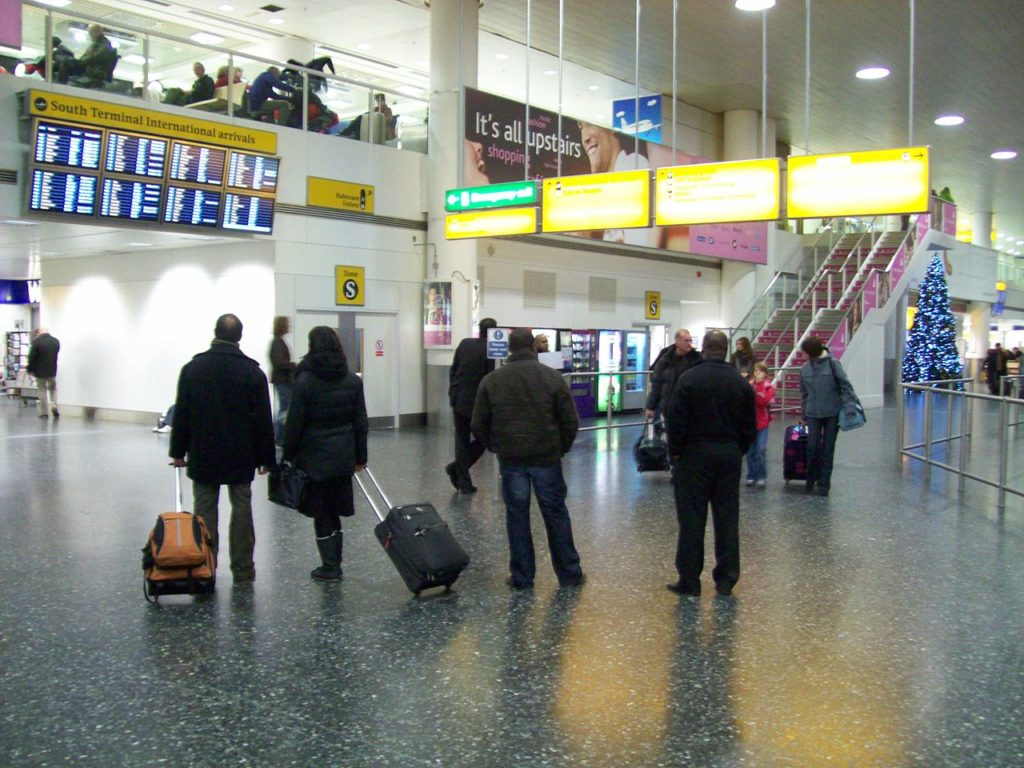

Source: Dbx54
Terminals
The airport has two terminals, South and North. Both have shops and restaurants landside and airside, and all areas are accessible to disabled passengers. There are facilities for baby changing and feeding. Business travellers have specialised lounges. The North and South Terminals are connected by a 0.75-mile (1.21 km), elevated, two-way automated people mover landside. They are not connected once past security.
South Terminal
The official opening of the central and main pier of what is now the South Terminal, with 11 aircraft stands, was on 9 June 1958. Gatwick was one of the world’s first airports with an enclosed pier-based terminal, which allowed passengers to walk under cover to waiting areas near the aircraft (with only a short walk outdoors). Another feature of Gatwick’s new air terminal was its modular design, permitting subsequent, phased expansion.
As passenger numbers grew, a circular satellite pier was added to the terminal building. It was connected to the main terminal by the UK’s first automated people mover system. This replaced the original North pier dating from 1962; and the people mover was subsequently replaced with a walkway and travelators.
North Terminal
Construction began on the North Terminal on land previously earmarked for a second runway in the draft plan of May 1970. This was the largest construction project south of London in the 1980s, costing £200 million. In 1991 a second aircraft pier was added to the North Terminal.
On 16 May 2005 the new Pier 6 opened at a cost of £110 million, adding 11 pier-served aircraft stands. The pier is linked to the North Terminal’s main building by the largest air passenger bridge in the world, spanning a taxiway and providing passengers with views of the airport and taxiing aircraft.
A large extension to the terminal was opened by former Prime Minister John Major in November 2011.
Terminal assignments and rearrangements
As part of a seven-year strategic commercial partnership between Gatwick and EasyJet, the airport proposed a number of changes to individual airlines’ terminal locations. These would see EasyJet consolidate all its Gatwick operations in the North Terminal, while British Airways and Virgin Atlantic would swap their terminals. Gatwick believes that these terminal moves improve the airport’s operational efficiency and resilience, as the use of different terminals by EasyJet and British Airways reduces pressure on the North Terminal’s check-in, security, boarding and ramp areas at peak times. In addition, a terminal swap by Virgin frees up lounge and gate space for BA long-haul passengers in the South Terminal and, unlike BA’s current short-haul schedules, Virgin’s long-haul schedules do not clash with EasyJet’s busy schedule in the North Terminal due to the airlines’ differing peak times.
It was confirmed in January 2015 that British Airways would move all its flights to the South Terminal in November 2016 while all EasyJet flights will be consolidated in the North Terminal at the same time. However it was decided in February 2016 to postpone the agreed relocation of airlines until 25 January 2017, to avoid operational disruptions over the 2016–17 Christmas season and to give all parties involved enough time to deal with any unforeseen issues ahead of the February 2017 half-term holidays. The relocation of these airlines was accomplished by the revised date on 25 January 2017.
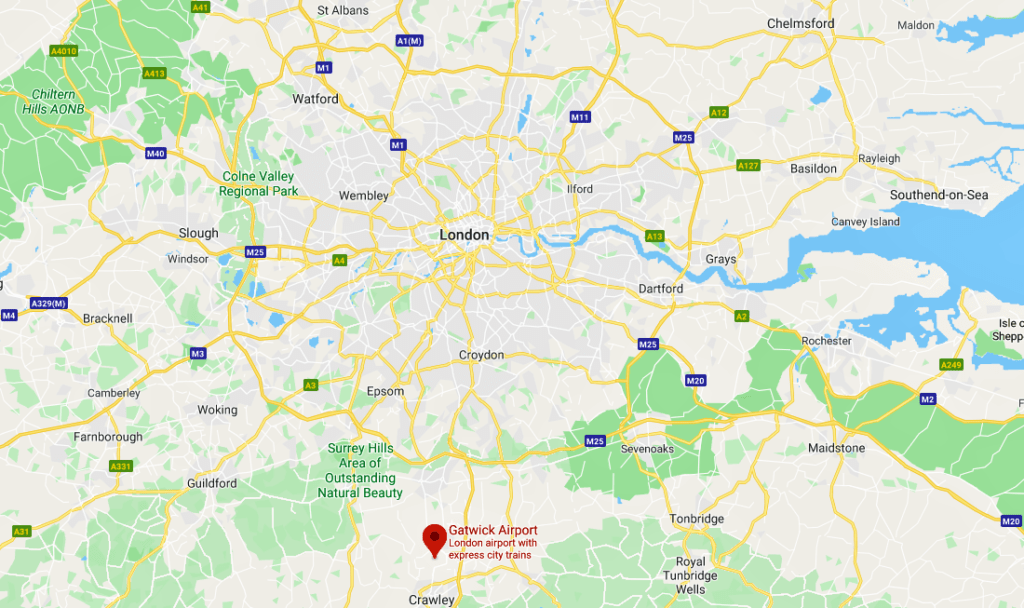

Airlines and destinations
The following airlines operate regular scheduled and charter flights to and from Gatwick Airport:
| Airlines | Destinations |
|---|---|
| Aegean Airlines | Seasonal: Athens |
| Aer Lingus | Dublin, Knock |
| Air Arabia Maroc | Marrakech, Tangier |
| airBaltic | Riga, Tallinn, Vilnius |
| Air Europa | Madrid |
| Air Malta | Malta |
| Air Transat | Toronto–Pearson Seasonal: Montréal–Trudeau, Vancouver |
| Aurigny | Guernsey |
| Belavia | Minsk |
| BH Air | Seasonal: Burgas, Varna |
| British Airways | Algiers, Alicante, Amsterdam, Antigua, Barbados, Bergamo, Bermuda, Bilbao, Bordeaux, Cancún, Dubrovnik, Edinburgh, Faro, Funchal, Genoa, Glasgow, Gran Canaria, Grenada, Jersey, Kingston, Lanzarote, Las Vegas, Málaga, Malta, Marrakesh, Mauritius, Naples, New York–JFK, Nice, Orlando, Paphos, Porto, Port of Spain, Providenciales, Punta Cana, Rome–Fiumicino, St. Kitts, St. Lucia–Hewanorra, Salzburg, San José de Costa Rica, Seville, Tampa, Tenerife–South, Tirana, Tobago, Turin, Venice, Verona Seasonal: Antalya, Bari, Cagliari, Cape Town, Catania, Cologne/Bonn, Corfu, Dalaman, Geneva, Grenoble, Heraklion, Ibiza, Innsbruck, Kos, Larnaca, Lima, Lyon, Menorca, Nuremberg, Palma de Mallorca, Rhodes, Thessaloniki, Toronto–Pearson, Vienna |
| Cathay Pacific | Hong Kong |
| China Airlines | Taipei–Taoyuan |
| China Eastern Airlines | Shanghai–Pudong |
| China Southern Airlines | Wuhan (begins 13 July 2020) |
| Corendon Airlines | Seasonal: Antalya (resumes 16 June 2020), Heraklion (begins 3 June 2021), Rhodes (begins 3 June 2021) |
| Croatia Airlines | Seasonal: Split |
| easyJet | Aarhus, Agadir, Alicante, Almería, Amsterdam, Ancona, Athens, Barcelona, Bari, Basel/Mulhouse, Belfast–International, Berlin–Tegel, Bologna, Bordeaux, Budapest, Catania, Copenhagen, Düsseldorf, Edinburgh, Faro, Fuerteventura, Funchal, Geneva, Gibraltar, Glasgow, Granada, Gran Canaria, Hamburg, Hurghada, Innsbruck, Inverness, Isle of Man, Jersey, Kraków, Lanzarote, Larnaca, Lisbon, Ljubljana, Luxembourg, Lyon, Madrid, Málaga, Malta, Marrakech, Marseille, Milan–Linate, Milan–Malpensa, Montpellier, Munich, Murcia, Nantes, Naples, Nice, Olbia, Palermo, Palma de Mallorca, Paphos, Paris–Charles de Gaulle, Pisa, Porto, Prague, Reykjavík–Keflavík, Rome–Fiumicino, Seville, Sharm El Sheikh (resumes 30 September 2020), Sofia, Stuttgart, Tallinn, Tenerife–South, Thessaloniki, Tirana, Toulouse, Valencia, Venice, Verona, Vienna, Zurich Seasonal: Ajaccio, Antalya, Aqaba, Bastia, Biarritz, Bodrum, Brindisi, Chania, Corfu, Dalaman, Dubrovnik, Enfidha, Figari, Friedrichshafen, Grenoble, Heraklion, Ibiza, Izmir, Jerez de la Frontera, Kalamata, Kefalonia, Klagenfurt, Kos, La Palma, La Rochelle, Menorca, Mykonos, Östersund, Preveza/Lefkada, Pula, Rhodes, Rovaniemi, Salzburg, Santiago de Compostela, Santorini, Split, Tel Aviv, Tirana (begins 26 June 2020), Tivat, Turin, Varna, Volos, Zadar, Zakynthos |
| easyJet Europe | Amsterdam, Bacelona, Berlin–Schönefeld, Bordeaux, Lisbon, Lyon, Milan–Malpensa, Naples, Palma de Mallorca, Paris–Charles de Gaulle, Porto, Toulouse, Venice |
| EgyptAir | Seasonal: Sharm El Sheikh |
| Emirates | Dubai–International |
| Finnair | Seasonal: Ivalo, Kittilä |
| Georgian Airways | Tbilisi |
| Iberia Express | Madrid |
| Icelandair | Reykjavík–Keflavík |
| Iraqi Airways | Baghdad1, Erbil, Sulaimaniyah |
| Jazeera Airways | Kuwait City |
| Montenegro Airlines | Seasonal: Tivat |
| Norwegian Air Shuttle | Barcelona, Bergen, Boston, Buenos Aires–Ezeiza, Copenhagen, Gothenburg, Gran Canaria, Helsinki, Los Angeles, Málaga, Miami, New York–JFK, Orlando, Oslo–Gardermoen, Rio de Janeiro–Galeão, San Francisco, Stavanger, Stockholm–Arlanda, Tampa, Tenerife–South, Trondheim Seasonal: Austin, Denver, Rovaniemi, Tromsø |
| Nouvelair | Seasonal: Enfidha |
| Qatar Airways | Doha |
| Rossiya | Saint Petersburg |
| Royal Air Maroc | Casablanca |
| RwandAir | Kigali2 |
| Ryanair | Alicante, Cork, Dublin, Shannon |
| Swiss International Air Lines | Seasonal: Geneva |
| TAP Air Portugal | Lisbon, Porto |
| TUI Airways | Agadir, Alicante, Boa Vista, Cancún, Enfidha, Fuerteventura, Funchal, Gran Canaria, Hurghada, Lanzarote, La Palma, Liberia, Málaga, Marrakesh, Marsa Alam, Mauritius, Montego Bay, Paphos, Puerto Vallarta, Punta Cana, St. Lucia–Hewanorra, Sal, Sharm El Sheikh, San José del Cabo, Tenerife–South Seasonal: Alghero, Almeria, Antalya, Aruba, Banjul (begins 3 November 2020), Barbados, Bodrum, Burgas, Catania, Chania, Colombo–Bandaranaike, Corfu, Dalaman, Dubrovnik, Faro, Girona, Goa, Heraklion, Ibiza, Innsbruck, Ivalo, İzmir, Jerez de la Frontera, Kavala, Kefalonia, Kittilä, Kos, Kuusamo, Lamezia Terme, Langkawi, Larnaca, La Romana, Menorca, Naples, Olbia, Orlando/Sanford, Palma de Mallorca, Pattaya–U-Tapao, Phuket, Phu Quoc, Podgorica, Porto Santo, Preveza/Lefkada, Pula, Reus, Rhodes, Rijeka, Rovaniemi, Salzburg, Samos, Santorini, Skiathos, Split, Thessaloniki, Varna, Venice, Verona, Zakynthos |
| Tunisair | Tunis |
| Turkish Airlines | Istanbul Seasonal: Antalya, Bodrum, Dalaman |
| Ukraine International Airlines | Kiev–Boryspil |
| Vueling | Alicante, Barcelona, Bilbao, Florence, Paris–Charles de Gaulle, Rome–Fiumicino Seasonal: Asturias, Valencia |
| WestJet | Calgary, Toronto–Pearson Seasonal: Halifax, Vancouver |
| Wizz Air | Bucharest, Budapest, Cluj-Napoca, Gdańsk, Kraków, Sofia |
Notes
- ^1 Iraqi Airways’ flights between Gatwick and Baghdad stop in Malmö. However, the airline does not have the rights to transport passengers solely between Gatwick and Malmö.
- ^2 Rwandair’s flights between Gatwick and Kigali stop in Brussels. However, the airline does not have the rights to transport passengers solely between Gatwick and Brussels.
Ground transport


Source: Dbx54
Gatwick has set goals of 40% public transport use by the time annual passenger traffic reaches 40 million (in 2015) and 45% by the time it reaches 45 million.
Road
The airport is accessible from a motorway spur road at junction 9A of the M23, which links to the main M23 motorway 1 mile (1.6 km) east at junction 9. The M23 connects with London’s orbital motorway, the M25, 9 miles (14 km) north; this provides access to much of Greater London, the South East and beyond, and the M23 is the main route for traffic to the airport. Gatwick is also accessible from the A23, which serves Horley and Redhill to the north and Crawley and Brighton to the south. The A217 provides access northwards to the town of Reigate. The airport has long- and short-stay car parks at the airport and off-site, although these are often full in summer. Local restrictions limit parking at (and near) Gatwick.
Rail
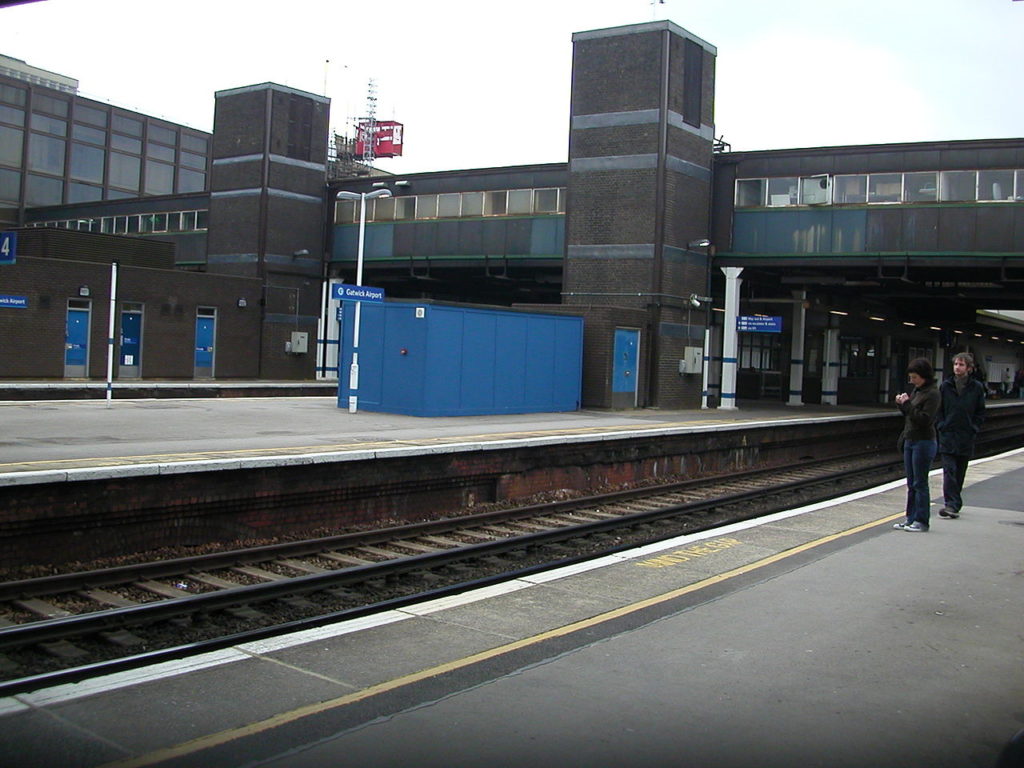

Source: Hassocks5489.
The airport railway station, which is next to the South Terminal, provides connections along the Brighton Main Line to Victoria and London Bridge stations in London and Brighton, Worthing, Eastbourne, Portsmouth, Chichester and Bognor Regis to the south. Although the Gatwick Express to Victoria (operated by Southern) is the best-known service from the station, other companies (including Thameslink and Great Western Railway) also use the station and Southern services Victoria and London Bridge under its own name. Thameslink provides direct trains to Luton Airport; Great Western Railway trains directly link Gatwick Airport with Guildford and Reading for onwards connections to Oxford, Bristol, Plymouth and Cardiff. Pedestrians may reach Heathrow by a X26 Express Bus outside East Croydon station, an intermediate stop for rail service to London.
London Oyster Cards and contactless cards have been accepted on all rail routes from Gatwick Airport into London since January 2016.
Bus
National Express Coaches operates coaches to Heathrow Airport, Stansted Airport and cities and towns throughout the region and country. Oxford Bus Company operates direct services to Oxford, and EasyBus operates mini-coaches from both terminals to Earls Court and West Brompton.
Local buses connect the North and South Terminals with Crawley, Horley, Redhill, Horsham and Caterham. Services are offered by Metrobus and Fastway, a partly guided bus rapid transit system which was the first of its kind to be built outside a major city.
Bicycle
Route 21 of the National Cycle Network passes under South Terminal, allowing virtually traffic-free cycling and walking northwards to Horley and southwards to Three Bridges and Crawley. A goods-style lift runs between the terminal and ground level (labelled “Lift to Cycle Route”), near Zone L.
Terminal transfer
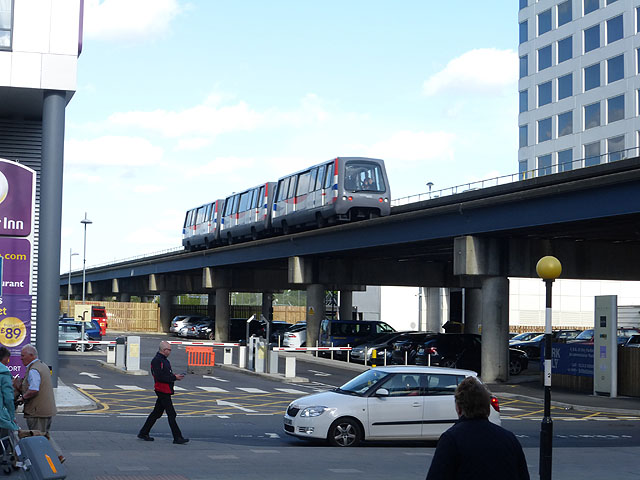

Source: From geograph.org.uk
The airport’s North and South Terminals are connected by a 0.75 miles (1.21 km), elevated, two-way automated people mover track. The transit shuttle normally consists of two automatic, three-car, driver-less trains. Although colloquially known as a “monorail”,[151] the shuttle instead runs on a dual, concrete track with rubber tyres. The transit is ground-side, and besides linking the two terminals also serves to link the North terminal to the airport railway station.
The shuttle opened in 1987, along with the North Terminal, and initially used Adtranz C-100 people-mover cars which remained in operation until September 2009, by which time they had travelled a total of 2.5 million miles (4 million km). Gatwick began upgrading its shuttle service in April 2008, with a bus replacement service in place from September 2009. A new operating system and shuttle cars (six Bombardier CX-100 vehicles) was installed, and the guideway and transit stations were refurbished at a total cost of £45 million. The system re-opened on 1 July 2010, two months ahead of schedule; it featured live journey information and sensory technology to count the number of passengers at stations.
An earlier transit system, that opened in 1983 to link the main terminal (now the South Terminal) to the (then new) circular satellite pier, was the UK’s first automated people-moving system. This system has since been replaced by a walkway-and-moving walkway link, although the remains of the elevated guideway are still visible.
Expansion proposals
Gatwick has been included in a number of reviews of airport capacity in southeastern England. Expansion options have included a third terminal and a second runway, although a 40-year agreement not to build a second runway was made in 1979 with West Sussex County Council. Expanded operations would allow Gatwick to handle more passengers than Heathrow does today, with a new terminal between two wide-spaced runways. This would complement or replace the South Terminal, depending on expected future traffic.
Airport management’s proposal for a second runway (south of the existing runway and airport boundary) were unveiled in July 2013. This was shortlisted for further consideration by the Airports Commission in December 2013, and the commission’s final report was published in July 2015. Another proposal would extend the North Terminal south, with a passenger bridge in the area currently occupied by aircraft stands without jet bridges. Gatwick’s draft master plan (released for consultation on 13 October 2011) apparently dropped the passenger-bridge plan in favour of a mid-field satellite (next to the control tower) linking to the North Terminal as part of an expanded 2030 single-runway, two-terminal airport.
In late 2011, the Department for Transport (DfT) also began a feasibility study for a high-speed rail link between Gatwick and Heathrow as part of a plan combining the airports into a “collective” or “virtual hub”, Heathwick. The scheme envisages a high-speed rail route parallel to the M25, covering 35 miles (56 km) in 15 minutes. Trains would reach speeds of 180 mph (290 km/h), and passengers would need to pass through immigration (or check in) only once. A 2018 proposal for a high-speed railway link to Heathrow, HS4Air, is currently being considered by the DfT. The proposal is part of a scheme to link the High Speed 1 and High Speed 2 railway lines and connect regional cities in Britain to the Channel Tunnel.[160] The DfT will respond to the HS4Air plans in the autumn of 2018.
On 1 July 2015, the Airports Commission submitted their final report, recommending the expansion of Heathrow Airport as opposed to Gatwick. Whilst the commission recognised Gatwick’s benefits and relatively less environmental consequences than Heathrow, they felt the economic benefits of Gatwick vs. Heathrow were not as great, nor as broad-ranging.[163] Gatwick disputed the findings.
Accidents and incidents
- 15 September 1936 – A British Airways Ltd de Havilland DH 86 on a night mail flight to Germany crashed on takeoff, killing the airline’s chief pilot and two crew members.
- November 1936 – A British Airways Ltd Fokker F 12 crashed in a wood 4.5 miles (7.2 km) south of Gatwick on its final approach to the airport under a low ceiling in poor visibility, killing both pilots and seriously injuring the flight engineer.
- 17 February 1959 – A Turkish Airlines Vickers Viscount 794D (registration: TC-SEV) on an international charter flight crashed in heavy fog at Newdigate, Surrey, on its approach to Gatwick after striking trees. Fourteen of the 24 on board died, and Turkish Prime Minister Adnan Menderes was amongst the survivors.
- 5 January 1969 – A Boeing 727-113C (registration: YA-FAR) operating flight 701 of Ariana Afghan Airlines arriving from Frankfurt Airport, Germany, crashed into a house in Fernhill (near Horley, Surrey) in low visibility. The flaps were not extended to maintain flight at final-approach speed. Forty-eight of the 62 on board died, in addition to two on the ground.
- 28 January 1972 – A British Caledonian Vickers VC10-1109 (registration: G-ARTA) with no passengers aboard sustained severe structural damage as a result of a hard landing at Gatwick at the end of a short ferry flight from Heathrow, where the aircraft had been diverted due to fog at Gatwick. After touching down on runway 08 and applying spoilers and reverse thrust, the aircraft became airborne again, bounced twice and landed heavily. This resulted in a burst front wheel tyre, a separated wheel and a crumpled fuselage (immediately in front of and behind the wings). A survey of the aircraft’s damage revealed that its airframe was bent out of shape, requiring extensive repairs to be restored to airworthiness. Since the repairs were not cost-effective, the airline’s management decided to cannibalise the aircraft for spare parts before scrapping it at Gatwick in 1975.
- 20 July 1975 – A British Island Airways (BIA) Handley Page Dart Herald 201 (registration: G-APWF) was involved in a runway accident while departing on a scheduled flight to Guernsey. The aircraft lifted off from runway 26 after a ground run of 2,490 feet (760 m), and appeared airborne for 411 ft (125 m) (with its landing gear retracting), before the rear underside of the fuselage settled back onto the runway and brought the aircraft to a stop. An investigation concluded that the landing gear was retracted before the aircraft had become established in a climb and the flap setting and takeoff speed were incorrect. Although the aircraft incurred substantial damage, none of the 45 occupants were hurt.
- 19–21 December 2018 – Major disruption to the airport was caused by a drone flying near the runway, which was shut for about six hours on the 19th. The airport reopened at 03:01 the next morning until another sighting forced it to close again about 45 minutes later. As of 00:15 on the 21st, the airport was still closed with about 110,000 passengers and 760 flights affected. Officials called the drone flying a “deliberate act of disruption”, but did not classify it as terrorism. The army were deployed to assist police in ending the incident. The runway reopened with limited capacity at around 06:00 on the 21st. There was another suspension of flights from 17:10 to 18:23 on the 21st. Later that day a man and a woman were arrested in connection with the incident; they were released without charge on 23 December with Sussex Police saying that they “are no longer suspects”.
Source: wikipedia
